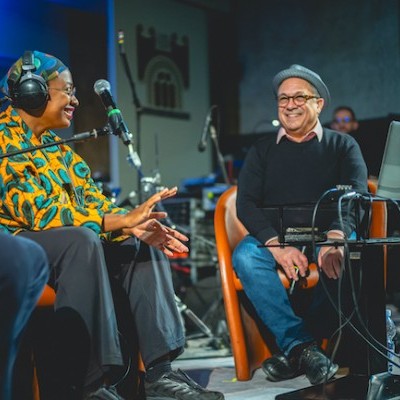Jul 9, 2024 11:35 AM
Trumpeter, Educator Jim Rotondi Dies at 61
Jim Rotondi, a renowned hard-bop trumpeter, composer and educator, died suddenly on July 7 at a hospital in France. He…

Manhattan Transfer, from left: Alan Paul, Cheryl Bentyne, Janis Siegel and Trist Curless
(Photo: John Abbott)Acclaimed vocal jazz group Manhattan Transfer is enjoying a new phase in its lengthy career. The band recently released it first new album in nearly a decade.
One of the most successful and versatile vocal groups in history, Manhattan Transfer was the first act ever to win Grammy awards in the pop and jazz categories in the same year (1981). Its 1985 all-jazz album, Vocalese, also made Grammy history by receiving a record 12 nominations (it won two). The group frequently explores multiple genres, moving easily between pop, jazz, gospel, funk and doo-wop.
Most of those elements are present on its new, pop-leaning album The Junction (BMG). The vocal quartet benefits from an inspired collaboration with Mervyn Warren (one of the founders of a cappella powerhouse Take 6), who produced and arranged the vocals.
The Junction is the group’s first recording since losing founder/bass singer Tim Hauser to a heart attack in 2014 at age 72. The new Manhattan Transfer consists of original members Alan Paul (tenor) and Janis Siegel (alto), who have been with the band since its founding in 1972; longtime member Cheryl Bentyne (soprano, since 1979); and a new member, bass/baritone Trist Curless, who is a veteran of a cappella group M-Pact. Curless had once subbed for Hauser for six months (prior to Hauser’s return to the group), so he was a natural choice to fill the bass spot.
Jazz fans will find plenty to love, including “Cantaloop (Flip Out!),” which is based on Herbie Hancock’s 1964 jazz standard “Cantaloupe Island” and Us3’s 1993 hip-hop hit “Cantaloop,” which sampled Hancock’s recording. Manhattan Transfer’s version includes an uncanny lead vocal by Bentyne, channeling Freddie Hubbard’s original trumpet solo.
There’s also a highly danceable, fully tricked-out version of the 1950s-era classic “Tequila,” combined with Paul’s original composition “The Way Of The Booze;” and Grace Kelly’s “Blues For Harry Bosch,” with Kelly’s sultry alto sax and new lyrics by Bentyne that lovingly send up film noir.
The five originals include the retro swing of Paul’s “Swing Balboa;” the delirious funk of Siegel’s “Shake Ya Boogie;” and “Sometimes I Do,” a soulful ballad by Warren, whose production features infectious synthesized funk beats, lush strings, and, of course, the quartet’s unique blend and luscious harmonies.
“We wanted to do a pop album, not just a jazz album,” Paul told DownBeat during a conference call with Curless from Los Angeles, “something that had wider boundaries and expressed different sides of Manhattan Transfer. There was a time when we were a Top 40 pop group. We wanted to express that on this album. Each song is like a chapter, representing some element of what we’ve done before.”
The group was eager to explore the new musical possibilities generated by the addition of new member Curless. Paul made it clear that, in a sense, there was no replacing Hauser. “Losing Tim was very difficult; it was a very big gap to fill … his personality and what he contributed to the group. We had to find someone who could sing the bass parts, but, more than that, create something new and fresh—a new element. That’s what we found with Trist. He has an amazing passion for music and for harmony.”
Curless, 46, reflected on what it means to become a member of the legendary outfit: “It’s pretty overwhelming and surreal to be part of a group that I grew up listening to and that was so influential on my musical development.”
Paul sees three distinct chapters of the group’s story: “From 1972 to 1979, with [original member] Laurel Masse, we were pretty much into nostalgia, with tails and tuxedos. We were eclectic but doing a lot of retro music. When Laurel left the group and we found Cheryl, in a way it was like where we are now. With the album Extensions [1979], we felt like, ‘Let’s just be free, break down the barriers and do whatever we’re feeling.’
“We were reborn twice; once when Cheryl joined the group. And now, with Trist, we’re reborn again.” DB

Jim Rotondi was acclaimed for his wide, round trumpet tone, remarkable virtuosity and assured swing.
Jul 9, 2024 11:35 AM
Jim Rotondi, a renowned hard-bop trumpeter, composer and educator, died suddenly on July 7 at a hospital in France. He…

Charles Lloyd, seen here at the 2024 New Orleans Jazz & Heritage Festival, makes DownBeat Poll history!
Jul 11, 2024 12:23 PM
The incomparable Charles Lloyd swept the 72nd Annual DownBeat Critics Poll, becoming the first artist ever to earn…

“Being president of Blue Note has been one of the coolest things that ever happened to me,” Was said. “It’s a gas to serve as one of the caretakers of that legacy.”
Jun 4, 2024 12:21 PM
Sitting with Don Was is a comfortable and unhurried exercise. He may seem slightly reserved at first, but ideas and…

“She reminds me of my childhood and makes we want to cry,” Cécile McLorin Salvant, pictured here with writer Ashley Kahn, said of Dianne Reeves.
Jun 11, 2024 12:31 PM
Italy’s Umbria Jazz Winter is one of those rare annual festivals that not only coincides with a major holiday —…

Maria Schneider said of Decades, her new compilation release: “I just wanted to create something, put it in a beautiful box and say, ‘Look at what we did.‘”
Jun 18, 2024 12:00 PM
Maria Schneider opened the sleek black box and placed it on a coffee table in her Manhattan apartment. Inside lay the…